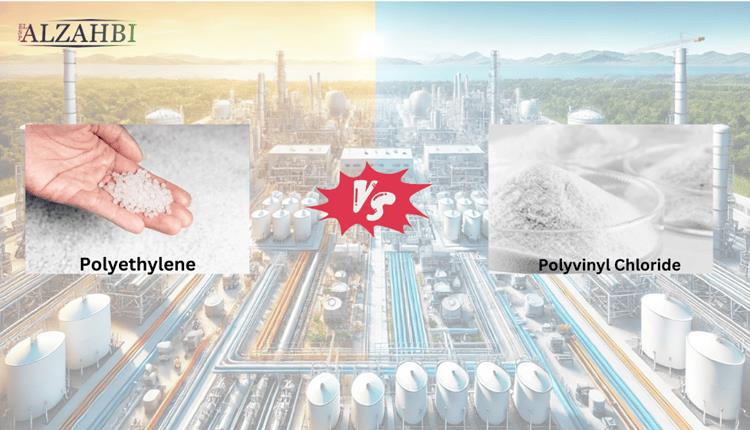
- 07 August 2024
- 1120 Views
Polyethylene (PE) and Polyvinyl Chloride (PVC) are two of the most widely used synthetic polymers in the world. These materials are integral to various industries, including packaging, construction, and manufacturing. Understanding the differences between these two polymers is essential for making informed decisions about their applications.
Overview of Polyethylene (PE) and Polyvinyl Chloride (PVC)
Polyethylene (PE) and Polyvinyl Chloride (PVC) are both versatile polymers used in a wide range of applications. PE is known for its lightweight and flexible properties, making it ideal for packaging and containers. PVC is valued for its durability and rigidity, which makes it suitable for construction materials, plumbing, and electrical insulation.
Difference Between Polyethylene Polymer and Polyvinyl Chloride
| Property | Polyethylene (PE) | Polyvinyl Chloride (PVC) |
|---|---|---|
| Chemical Composition | (C2H4)n | (C2H3Cl)n |
| Density | Lower | Higher |
| Flexibility | Higher | Lower |
| Durability | Moderate | High |
| Melting Point | Lower | Higher |
| Common Uses | Packaging, containers, household goods | Construction, plumbing, electrical insulation |
| Environmental Impact | Less toxic, recyclable | Potentially toxic, recyclable, non-biodegradable |
Chemical Composition of PE and PVC
Polyethylene (PE) is composed of repeating units of ethylene (C2H4), forming a long chain of carbon atoms bonded to hydrogen atoms. Its simple structure makes it highly versatile. Polyvinyl Chloride (PVC), on the other hand, consists of repeating units of vinyl chloride (C2H3Cl). The presence of chlorine atoms adds complexity to its structure and gives PVC its unique properties, such as fire resistance.
Physical Properties of PE and PVC
- Density: PE has a lower density, making it lighter and more flexible. PVC's higher density contributes to its rigidity and strength.
- Flexibility: PE is more flexible and has a lower melting point, which makes it easier to mold and shape. PVC is less flexible but more durable, making it ideal for construction materials.
- Durability: PVC's higher durability and resistance to environmental factors make it suitable for long-term applications, especially in construction.
Polyethylene
Manufacturing Processes of Polyethylene and Polyvinyl Chloride
- Polyethylene: Produced through the polymerization of ethylene monomers, typically using catalysts such as Ziegler-Natta or metallocene. The process can produce various types of PE, including low-density polyethylene (LDPE) and high-density polyethylene (HDPE).
- Polyvinyl Chloride: Manufactured by polymerizing vinyl chloride monomers through suspension, emulsion, or bulk processes. Additives such as plasticizers can be included to modify its properties, making it either rigid (uPVC) or flexible (fPVC).
The Right Choice Between Polyethylene Polymer and Polyvinyl Chloride
Choosing between PE and PVC depends on the specific requirements of your application:
- For packaging and lightweight applications: Polyethylene is generally more suitable due to its flexibility, lightweight, and cost-effectiveness.
- For construction and durability: Polyvinyl Chloride is preferred for its strength, durability, and resistance to environmental factors.
Cost Comparison Between Polyethylene Polymer and Polyvinyl Chloride
- Polyethylene (PE): Generally less expensive due to simpler production processes and lower material costs. PE is widely used in cost-sensitive applications such as packaging and containers.
- Polyvinyl Chloride (PVC): Higher cost due to more complex manufacturing and the inclusion of additives. PVC's cost is justified by its superior durability and specialized applications.
Advantages of Polyethylene (PE)
- Lightweight: Easier to handle and transport, reducing logistics costs.
- Flexible: Suitable for a wide range of applications, including films, sheets, and containers.
- Chemical Resistance: Resistant to many chemicals, making it durable in various environments.
- Cost-Effective: Lower production costs make it ideal for high-volume, cost-sensitive applications.
Advantages of Polyvinyl Chloride (PVC)
- Durability: Highly durable and resistant to weathering, chemicals, and impact, making it suitable for construction and outdoor applications.
- Fire Resistance: Contains chlorine, which gives it inherent fire-retardant properties, enhancing safety in construction and electrical applications.
- Versatility: Can be made rigid or flexible with the addition of plasticizers, broadening its range of applications.
- Low Maintenance: Long-lasting with minimal maintenance required, reducing long-term costs.
Polyvinyl Chloride
Buy Polyethylene (PE) and Polyvinyl Chloride (PVC)
For purchasing options and pricing:
- When purchasing Polyethylene and Polyvinyl Chloride (PVC), it is important to consider the material's properties, quality, and suitability for the intended application. Comparing prices between different suppliers and checking reviews from previous customers can help you make the best choice. It is also important to consider the recyclability and environmental impact of products, especially in industries with more stringent standards.
- Elsapa Alzahbi is one of the well-known suppliers of polyethylene and Polyvinyl Chloride, which has established its name in the market by providing quality products and excellent customer service. The company offers a variety of polyethylene and polypropylene for various applications, including grades optimized for heat and chemical resistance. Elsapa Alzahbi also offers technical advice to choose the best type of polymer based on the specific needs of projects, which can be especially useful for buyers who are less experienced in choosing new products.
FAQ & Conclusion
FAQ
What are the main differences between PE and PVC?
- PE is more flexible and lightweight, while PVC is more rigid and durable.
Which is better for construction, PE or PVC?
- PVC is generally better for construction due to its higher durability and fire resistance.
Can PE and PVC be recycled?
- Yes, both can be recycled, but the processes differ. PVC recycling is less common due to the potential release of harmful chemicals.
in Conclusion: Understanding the differences between Polyethylene and Polyvinyl Chloride is essential for selecting the right material for your needs. Both polymers offer unique benefits and have significant industrial importance. By considering factors such as chemical composition, physical properties, and cost, you can make informed decisions that align with your specific requirements.
